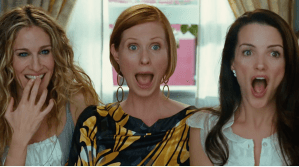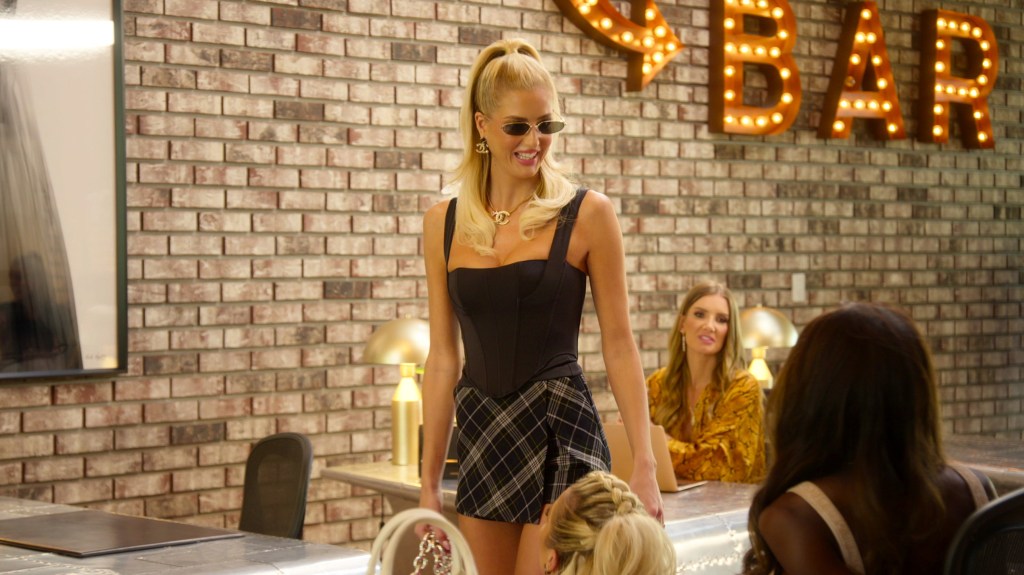When Sarah Jessica Parker announced And Just Like That, HBO Max’s new chapter of Sex and the City, I didn’t expect the series to be capable of any real portrayal of Black people’s humanity. The first iteration of the show inspired droves of people to live out SATC’s moneyed picture of cosmopolitan bliss, but as a Black woman who grew up in New York City as the show was filming, there was no part of it that felt remotely accurate to my experience of where I lived.
Sex and the City made Carrie, Charlotte, Miranda, and Samantha, four well-off white women, cultural ambassadors for New York City—that is, HBO’s whitewashed version of it, where Brooklyn was a dirty word. The only Black characters on the show were given throwaway roles within stereotypes: They were sexual conquests or the help. In season three, Samantha briefly dates Chivon, a flashy music executive, and can’t help but refer to his “big Black cock.”
Videos by VICE
And Just Like That is trying to position itself as a slightly different, more progressive version of its predecessor. Death and estranged friendships—both real and fictitious—meant that some of Carrie Bradshaw’s inner circle, most notably Samantha, would not be returning to the series after 15 years away. In their absence, viewers are introduced to a few new faces, two of whom are New Yorkers that SATC rarely acknowledged: Black women. But as And Just Like That draws closer to its season finale, the first season of the show has been concerned with correcting its reputation instead of depicting its Black characters as full people. In other words, it wants everyone to know it has a Black friend—or in this case, two.
Dr. Nya Wallace, Miranda’s law professor at Columbia University, and documentarian Lisa Todd Wexley, who meets Charlotte at their children’s private school, do not solve the show’s diversity issues. Nya and Lisa may help to fill a vacancy racially, but they do so at the same level of class privilege Miranda and Charlotte have. And, as the show’s title suggests, this all feels a bit sudden. If there’s anything to be learned from the frenzy of white allyship since the death of George Floyd, it’s to interrogate who the push for “diverse friendships,” as Charlotte calls them at one point, is really for, onscreen and off. Is it about meaningful connections, or satiating a need for reassurance about Not Being Like the Rest?
If simply having uncomfortable conversations counted for anything, the show would be a truly progressive leader. Although plenty others come close, there are few pieces of dialogue more awkward than when, in the first episode, Miranda mistakenly regards Nya as a student. When Nya asks why Miranda seems so surprised that she is the professor, Miranda points out her box braids, which are different from the hairstyle in her faculty photo on the university’s website. The room goes tense. “A law professor can’t have braids like mine? Why is that?” Nya asks.
After a pretty embarrassing case of word vomit, Miranda accepts defeat, but not before acknowledging her oversight. “Please forget I said anything about your hair,” she says. “Hair has nothing to do with appropriateness or intelligence or gravitas.” It’s not the wrong answer, but it’s so on the nose that it feels disingenuous. The scene has a secret brilliance, though, established by a moment that precedes it: In the park with her white friends, Miranda scoffs at the idea of dying her gray hair, on the grounds that women have more important things to do than keep up with appearances—only to be taught by a woman who changes her hair frequently because, culturally, it’s important to her.
Miranda’s interaction with Nya gets even more awkward when they end up on the same subway platform after class. The agitation on Nya’s face is noticeable as Miranda approaches her even though she’s on the phone. More word vomit ensues as Miranda explains that she’s taking Nya’s class because didn’t think her corporate law career and “pink pussy hat” protests were making real change. Wallace’s silence is one that harks back to the summer of 2020—a time when Black people across the country were accosted by white guilt. But the best part is not in what Nya says in response to Miranda, but what she does: She flashes a fake smile and walks to the next train car, where she can be free from Miranda’s urge to treat her like the only Black woman in New York City.

If the beginning of Nya’s and Miranda’s friendship establishes how different they are, Lisa was created to be the mirror image of Charlotte. (You can tell because of the way Anthony calls Lisa “the Black Charlotte.”) When Charlotte coordinates a dinner party only to realize that the Wexleys would be their only Black guests, she scrambles to find another Black couple to attend. As luck should have it, Lisa invites her over instead, where the tables have turned and Charlotte and her husband, Harry, are the minorities in the room. Despite Harry’s forced Zadie Smith and Michelle Obama name-drops and a case of mistaken identity insinuating Black women look alike, Charlotte holds her own when she defends Lisa’s art collection to her mother-in-law.
As a viewer, I’m not entirely sure how I’m supposed to interpret this moment: Does Charlotte deserve props for being familiar with Black artists? Is this yet another moment where Charlotte, a former gallerist, is trying to lend credence to Lisa’s taste, or is it simply a friend helping out a friend? It’s hard to make the delineation when you’re dealing with characters who have never genuinely sought out “diverse friendships,” to borrow Charlotte’s phrasing.
That murkiness, instead of working as part of a complex picture of how these friendships might operate in reality, is dispelled with a neat, clichéd resolution. After the dinner party, Charlotte and Lisa realize just how similar they actually are: Both women were worried that the other would feel out of place in their respective worlds! “I was really panicked having you and Herbert over for dinner because I realized you would be the only Black couple there,” Charlotte says.
The writing here, as in Miranda’s apology to Nya, feels extremely generous, but not toward the characters it should be. In subplots, we see Nya struggling with decisions around pregnancy and Lisa dealing with family issues of her own, but the new Black members of the clique exist largely as reminders of the protagonists’ blind spots. Overall, much of the writing that takes place around the Black characters, rather than in their own dedicated storylines, only reaffirms who the creators think they’re writing for. When Nya is being attacked by a prankster in a Chucky Doll suit, Miranda is hesitant to come to her rescue. “It was unclear to me whether that was a white savior moment,” she tells Nya. “I think that was an any-savior-will-do kind of moment,” Nya replies.
The series functions as a form of edutainment focused on political correctness, whether it’s fumbling through interracial friendships, contemplating gender pronouns, or painstakingly defining and redefining a basic lexicon of certain identity politics. When Carrie invites herself to her Indian-American realtor Seema’s Diwali celebration, Seema encourages her to pick out a sari for the occasion. “You’re wearing it to a traditional ceremony at my family’s home,” she says. “That’s not cultural appropriation, that’s cultural appreciation.” This conversation is, to be generous, at least five years behind its time. The show’s need to constantly correct middle-aged white women from being inappropriate means the writers know their audience is probably also lost. As the TikTok philosophers say: “The girls that get it, get it. And the girls that don’t, don’t.”
Some girls never will. The clearest indication to me that And Just Like That hasn’t had a real change of heart is the reemergence of Carrie’s infamous, yet actually culturally appropriative nameplate necklace she once called “ghetto gold.” That necklace disrespected the pendant’s origins: Nameplates were popularized and treasured by Black and brown girls with elaborately spelled names that were never present on gift shop knicknacks. So though—and just like that!—Black women now exist in the world of Sex and the City, I still don’t recognize the people I knew, or the place I was raised, in its apologetic reboot. Carrie’s version of New York is still running the show.
Kristin Corry is a Senior Staff Writer for VICE.





